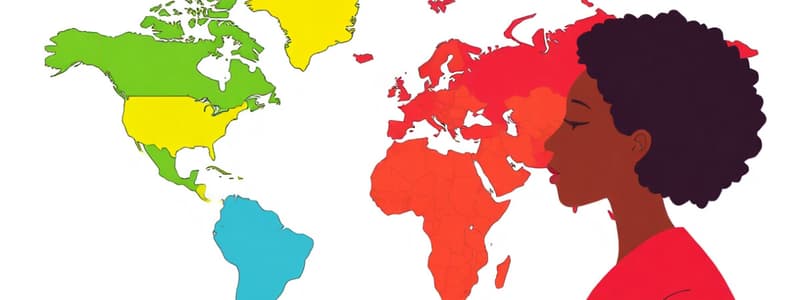Podcast
Questions and Answers
What is the primary focus of modernization theory?
What is the primary focus of modernization theory?
- Critiquing the impact of global capitalism.
- Establishing political control over developing nations.
- Promoting self-sufficiency in Third World countries.
- Expecting Third World countries to follow a similar developmental path as the West. (correct)
Which of the following describes a characteristic of world empires according to World Systems Theory?
Which of the following describes a characteristic of world empires according to World Systems Theory?
- Political and economic control is decentralized.
- Authority resides in multiple states.
- Economic structure is independent of political structure.
- Control is concentrated in a unified center. (correct)
Dependency theory critiques the form capitalist development takes in which context?
Dependency theory critiques the form capitalist development takes in which context?
- In post-colonial regimes.
- In the global market system.
- In developed nations exclusively.
- In developing Third World countries. (correct)
What is a key difference between World Systems Theory and Dependency Theory?
What is a key difference between World Systems Theory and Dependency Theory?
Which significant entity is primarily involved in international development aid programs?
Which significant entity is primarily involved in international development aid programs?
What obstacle does modernization theory identify as a barrier to development?
What obstacle does modernization theory identify as a barrier to development?
According to World Systems Theory, what factor enhances the connection between economic and political structures?
According to World Systems Theory, what factor enhances the connection between economic and political structures?
What does dependency theory primarily seek to provide for Third World countries?
What does dependency theory primarily seek to provide for Third World countries?
Which figure is most associated with the development of the world-economy/world-system theory?
Which figure is most associated with the development of the world-economy/world-system theory?
What concept describes the relationship where developed nations benefit disproportionately from exchanges with developing nations?
What concept describes the relationship where developed nations benefit disproportionately from exchanges with developing nations?
What was the primary focus of development aid after World War II?
What was the primary focus of development aid after World War II?
What is the main goal set by the Millennium Development Goals relevant to poverty?
What is the main goal set by the Millennium Development Goals relevant to poverty?
Which of the following best describes the Dependency School?
Which of the following best describes the Dependency School?
Which of the following issues was particularly highlighted in the 1980s in relation to development aid?
Which of the following issues was particularly highlighted in the 1980s in relation to development aid?
Which of the following best describes the qualitative change in development aid?
Which of the following best describes the qualitative change in development aid?
What term describes the outcomes of development efforts that are not directly related to economic indices?
What term describes the outcomes of development efforts that are not directly related to economic indices?
What new elements does the Human Development Index (HDI) incorporate compared to previous measures of development?
What new elements does the Human Development Index (HDI) incorporate compared to previous measures of development?
How did the HDI ranking of Norway in 2010 differ from its ranking based on gross domestic product?
How did the HDI ranking of Norway in 2010 differ from its ranking based on gross domestic product?
What primary aspect does the alternative and critical approach emphasize as a contributing factor to hunger?
What primary aspect does the alternative and critical approach emphasize as a contributing factor to hunger?
What significant change did the United Nations make in measuring development indices?
What significant change did the United Nations make in measuring development indices?
According to Marxist theories, what characterizes the relationship between workers and the capitalist class?
According to Marxist theories, what characterizes the relationship between workers and the capitalist class?
What concept introduced by Lenin describes the role of the state in terms of economic power?
What concept introduced by Lenin describes the role of the state in terms of economic power?
What was a primary criticism of Marxist theories in International Relations initially?
What was a primary criticism of Marxist theories in International Relations initially?
What does the concept of inequality experimentation refer to in the context of global issues?
What does the concept of inequality experimentation refer to in the context of global issues?
What primary factor led to the raw material race in the colonies according to Lenin?
What primary factor led to the raw material race in the colonies according to Lenin?
What was a significant outcome of the decolonization period in the 1970s?
What was a significant outcome of the decolonization period in the 1970s?
Which scholar is associated with the Dependency School in relation to development in Latin America?
Which scholar is associated with the Dependency School in relation to development in Latin America?
According to Johan Galtung, how is imperialism characterized?
According to Johan Galtung, how is imperialism characterized?
What does the term 'unequal exchange' refer to in the context of international relations?
What does the term 'unequal exchange' refer to in the context of international relations?
What is one solution proposed to counteract 'development of under-development'?
What is one solution proposed to counteract 'development of under-development'?
What was implied by Lenin regarding international relations?
What was implied by Lenin regarding international relations?
How do structuralists view the relationship between nations in the global economy?
How do structuralists view the relationship between nations in the global economy?
Flashcards
World-system
World-system
The study of how the global economy and its structures are organized and how they affect different countries and their development.
Centre/Periphery/Semi-periphery
Centre/Periphery/Semi-periphery
A model that divides the world into three categories based on their economic power and influence: Core countries (powerful and wealthy), Periphery countries (less developed and often exploited), and Semi-periphery countries (in-between, with some economic power but also subjected to core control).
Disconnection
Disconnection
The process of countries being left behind in economic development and unable to catch up with others.
Unequal exchange
Unequal exchange
Signup and view all the flashcards
Human development index
Human development index
Signup and view all the flashcards
Millennium development goals
Millennium development goals
Signup and view all the flashcards
Dependency School
Dependency School
Signup and view all the flashcards
Structuralism
Structuralism
Signup and view all the flashcards
Human Development Index (HDI)
Human Development Index (HDI)
Signup and view all the flashcards
Class Struggle
Class Struggle
Signup and view all the flashcards
Imperialism
Imperialism
Signup and view all the flashcards
Marxist Theory
Marxist Theory
Signup and view all the flashcards
Alternative and Critical Approach to Development
Alternative and Critical Approach to Development
Signup and view all the flashcards
Social and Political Extension of Development
Social and Political Extension of Development
Signup and view all the flashcards
Gender-Adjusted Development Index
Gender-Adjusted Development Index
Signup and view all the flashcards
Poverty as a Lack of Material and Immaterial Goods
Poverty as a Lack of Material and Immaterial Goods
Signup and view all the flashcards
Dependency
Dependency
Signup and view all the flashcards
Dependency Theory
Dependency Theory
Signup and view all the flashcards
Lenin's view of International Relations
Lenin's view of International Relations
Signup and view all the flashcards
Modernization Theory
Modernization Theory
Signup and view all the flashcards
World Systems Theory
World Systems Theory
Signup and view all the flashcards
Millennium Development Goals (MDGs)
Millennium Development Goals (MDGs)
Signup and view all the flashcards
Study Notes
Class 8: Development and International Relations
- Key figures include Immanuel Wallerstein, Johan Galtung, Karl Marx, Lenin, Samir Amin, Henrique Cardoso, and Enzo Faletto.
- Concepts include world-economy/world-system, center/periphery/semi-periphery, disconnection, unequal exchange, human development index, and millennium development goals.
- Development aid history shows different phases. Before WWII, aid was rare and tied to political interests. After WWII, aid intensified with the Truman Doctrine's "Point IV" and technical assistance. In 1960, the OECD Development Assistance Committee was formed. By 1970, developed nations committed to contributing 0.7% of their GDP to development aid but this goal was never reached.
- Inequalities and Marxism: Inequalities remain global issues, as does the application of Marxism to international relations. The dependency school and structuralism explore neo-Marxist interpretations of global power dynamics.
- Modernization theory supports the idea that developing nations should follow the developed world's path.
- The 1980s saw conditionality policies from the International Monetary Fund.
- In the 2000s, development aid focused on eradicating extreme poverty by 2015 through the Millennium Development Goals. Development aid was initially quantitative but also went through qualitative changes from a dominant to an alternative approach. The dominant approach emphasizes material goods while the alternative explores social good equity.
- Human Development Index (HDI): A composite index from the UN Development Programme that measures health, education, and living standards. The HDI goes beyond simple economic growth, acknowledging social components.
- World Systems Theory: A concept developed by Immanuel Wallerstein focusing on global economic and political systems.
- Dependency Theory: This theory examines how developing nations are dependent on developed ones and critiques the existing global economic structures.
- The Sustainable Development Goals (SDGs): 17 goals created by the UN in 2015 to address global challenges by 2030. These goals include social, economic, and environmental objectives.
Studying That Suits You
Use AI to generate personalized quizzes and flashcards to suit your learning preferences.




